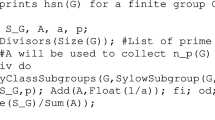Abstract
Let Φ be a reduced irreducible root system. We consider pairs (S, X (S)), where S is a closed set of roots, X(S) is its stabilizer in the Weyl group W(Φ). We are interested in such pairs maximal with respect to the following order: (S1, X (S1)) ≤ (S2, X (S2)) if S1 ⊆ S2 and X(S1) ≤ X(S2). The main theorem asserts that if Δ is a root subsystem such that (Δ, X (Δ)) is maximal with respect to the above order, then X (Δ) acts transitively both on the long and short roots in Φ \ Δ. This result is a wide generalization of the transitivity of the Weyl group on roots of a given length. Bibliography: 23 titles.
Similar content being viewed by others
References
A. Borel and J. Tits, “Unipotent elements and parabolic subgroups in reductive groups. I [Russian translation],” Matematica, 12, 97–104 (1971).
N. Bourbaki, Lie Groups and Algebras [Russian translation], Chaps. IV-VI, Mir, Moscow 1972).
N. A. Vavilov, “Maximal subgroups of Chevalley groups which contain a split maximal torus,” in: Rings and Modules, Leningrad (1986), pp. 67–75.
N. A. Vavilov, “Weight elements of Chevalley groups,” Dokl. AN SSSR, 298, No. 3, 524–527 (1988).
N. A. Vavilov, “Conjugacy theorems for subgroups of extended Chevalley groups which contain a split maximal torus, Dokl. AN SSSR, 299, No. 2, 269–272 (1988).
N. A. Vavilov, “Subgroups of Chevalley groips which contain a maximal torus,” Trudy Leningr. Mat. Obshch., 1, 64–109 (1990).
N. A. Vavilov, “Unipotent elements in the subgroups of extended Chevalley groups that contain a split maximal torus,” Dokl. RAN, 328, No. 5, 536–539 (1993).
N. A. Vavilov, A. Yu. Luzgarev, and I. M. Pevzner, “Chevalley groups of type E 6 in the 27-dimensional representation,” this issue, 5–68.
N. A. Vavilov and A. A. Semenov, “Long root semisimple elements in Chevalley groups,” Dokl. RAN, 338, No. 6, 725–727 (1994).
E. B. Vinberg and A. G. Elashvili, “Classification of trivectors in the nine-dimensional space,” Trudy Semin. Vekt. Analisis, 18, 197–233 (1978).
E. B. Dynkin, “Semisimple subalgebras of semisimple Lie algebras,” Mat. Sb., 30, No. 2, 349–362 (1952).
R. Carter, “Conjugacy classes in the Weyl group [Russian translation],” in: A Seminar on Algebraic Groups, Mir, Moscow (1973), pp. 288–306.
Yu. I. Manin, Cubic Forms: Algebra, Geometry, and Arithmetic [in Russian], Nauka, Moscow (1972).
A. Borel and J. de Siebenthal, “Les sous-groupes fermés connexes de rang maximal des groupes de Lie clos,” Comm. Math. Helv., 23, No. 2, 200–221 (1949).
R. W. Carter, “Conjugacy classes in the Weyl group,” Compositio Math., 25, No. 1, 1–59 (1972).
D. I. Deriziotis, “Centralizers of semisimple elements in a Chevalley group,” Comm. Algebra, 9, No. 19, 1997–2014 (1981).
A. J. Idowu and A. O. Morris, “Some combinatorial results for Weyl groups,” Math. Proc. Cambridge Phil. Soc., 101, No. 3, 405–420 (1987).
A. L. Harebov and N. A. Vavilov, “On the lattice of subgroups of Chevalley groups containing a split maximal torus,” Comm. Algebra, 24, No. 1, 109–133 (1996).
R. B. Howlett, “Normalizers of parabolic subgroups of reflection groups,” J. London Math. Soc., 21, No. 1, 62–80 (1980).
M. Golubitsky and B. Rothschild, “Primitive subalgebras of exceptional Lie algebras,” Pacific J. Math., 39, No. 2, 371–393 (1971).
N. A. Vavilov, “Intermediate subgroups in Chevalley groups,” in: Proceedings of the Conference on Groups of Lie Type and Their Geometries (Como-1993), Cambridge Univ. Press (1995), pp. 233–280.
N. A. Vavilov, “Do it yourself: structure theorems for Lie algebras of type El,” Zap. Nauchn. Semin. POMI, 281, 60–104 (2001).
N. Wallach, “On maximal subsystems of root systems,” Canad. J. Math., 30, No. 3, 555–574 (1968).
Author information
Authors and Affiliations
Additional information
__________
Translated from Zapiski Nauchnykh Seminarov POMI, Vol. 338, 2006, pp. 98–124.
Rights and permissions
About this article
Cite this article
Vavilov, N.A., Kharchev, N.P. Orbits of subsystem stabilizers. J Math Sci 145, 4751–4764 (2007). https://doi.org/10.1007/s10958-007-0306-z
Received:
Issue Date:
DOI: https://doi.org/10.1007/s10958-007-0306-z



